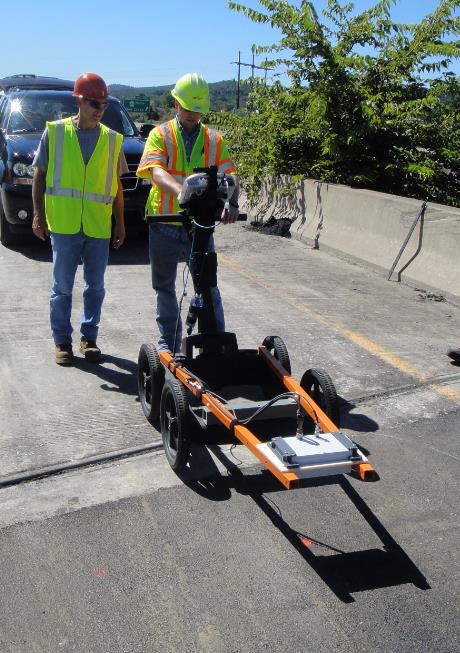New quality assurance device helps prevent pavement failures
Despite years of agencies trying to create defect-free asphalt pavements, many new roads have construction defects built into them. Both low- and high-density spots can lead to rapid pavement failure requiring more frequent repairs. Researchers have now developed a device — the rolling density meter — that can test pavement uniformity and hopefully avoid expensive early pavement failures.
What’s the problem?
Few things are more frustrating for taxpayers, road construction companies and departments of transportation (DOTs) than when a newly paved road prematurely fails. Usually the problem is caused by the pavement’s wearing surface failing before the end of its design life. This failure often results from a lack of construction uniformity, which can occur when variations exist in mix density. Until now uniformity testing required taking localized nuclear density readings or random core samples and measuring their density in the laboratory. Because random samples could not be taken from the entire road, localized defects were missed. Pavements begin to fail in places that are not tested.
Researchers anticipate that multiple rolling density meters can be mounted transversely onto a vehicle to provide close to 100 percent coverage of the new surface layer being placed.
What’s the solution?
What’s needed is a way to easily test the entire, newly paved road to help ensure its uniformity and also that layer compaction is within limits set by the DOT. Texas A&M Transportation Institute (TTI) researchers teamed with a manufacturer of ground penetrating radar to tailor a system for asphalt mixture evaluation. The manufacturer developed a device, dubbed the rolling density meter, which can be rolled over the roadway.
The meter includes an onboard radar that transmits an electrical magnetic pulse into the pavement. The reflections from the pavement surface are readily correlated to surface layer density, which allows the operator to monitor in real time the mix densities in a continuous one-step process. Currently, the radar is part of a four-wheeled device pushed over the pavement. Researchers anticipate that multiple rolling density meters can be mounted transversely onto a vehicle to provide close to 100 percent coverage of the new surface layer being placed.
How was the study done?
The new rolling density meter was developed and field tested on several pilot projects in four states as part of a project funded by the Strategic Highway Research Program 2. By making multiple passes at different transverse offsets across the new lane, the meter was able to essentially test 100 percent of the new surfaces and provided rapid feedback on the quality and uniformity of construction.
What’s next?
Based on the successful performance of the rolling density meter, researchers expect it to eventually become part of the specifications for road projects nationwide, replacing the labor intensive procedures currently in place. The new system can also be used to rapidly check the quality of longitudinal construction joints another source of early pavement performance problems.
Project Title
Pre-implementation of Infrared and Ground-Penetrating Radar Technologies for Improving Asphalt Mixture QualityProject Number
SHRP 2 Project R06(C)
Project Sponsor(s)
The Strategic Highway Research Program 2
Project Category
Infrastructure
Project Termination Date
October 2103
Project Publications
For More Information
Thomas Scullion, P.E.
Senior Research EngineerFlexible Pavements
Texas A&M Transportation Institute
The Texas A&M University System
3135 TAMU
College Station, TX 77843-3135
Ph. (979) 317-2321
[email protected]
